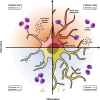The interplay of inflammation and remyelination: rethinking MS treatment with a focus on oligodendrocyte progenitor cells
- PMID: 38997755
- PMCID: PMC11245841
- DOI: 10.1186/s13024-024-00742-8
The interplay of inflammation and remyelination: rethinking MS treatment with a focus on oligodendrocyte progenitor cells
Abstract
Background: Multiple sclerosis (MS) therapeutic goals have traditionally been dichotomized into two distinct avenues: immune-modulatory-centric interventions and pro-regenerative strategies. Oligodendrocyte progenitor cells (OPCs) were regarded for many years solely in concern to their potential to generate oligodendrocytes and myelin in the central nervous system (CNS). However, accumulating data elucidate the multifaceted roles of OPCs, including their immunomodulatory functions, positioning them as cardinal constituents of the CNS's immune landscape.
Main body: In this review, we will discuss how the two therapeutic approaches converge. We present a model by which (1) an inflammation is required for the appropriate pro-myelinating immune function of OPCs in the chronically inflamed CNS, and (2) the immune function of OPCs is crucial for their ability to differentiate and promote remyelination. This model highlights the reciprocal interactions between OPCs' pro-myelinating and immune-modulating functions. Additionally, we review the specific effects of anti- and pro-inflammatory interventions on OPCs, suggesting that immunosuppression adversely affects OPCs' differentiation and immune functions.
Conclusion: We suggest a multi-systemic therapeutic approach, which necessitates not a unidimensional focus but a harmonious balance between OPCs' pro-myelinating and immune-modulatory functions.
Keywords: Demyelination; Immune-modulation; Immune-suppression; Multiple sclerosis; Myelin; Neurodegeneration; Neuroinflammation; Oligodendrocyte progenitor cell; Regeneration; Remyelination.
© 2024. The Author(s).
Conflict of interest statement
The authors declare that they have no competing interests.
Figures

References
Publication types
MeSH terms
LinkOut - more resources
Full Text Sources
Medical

